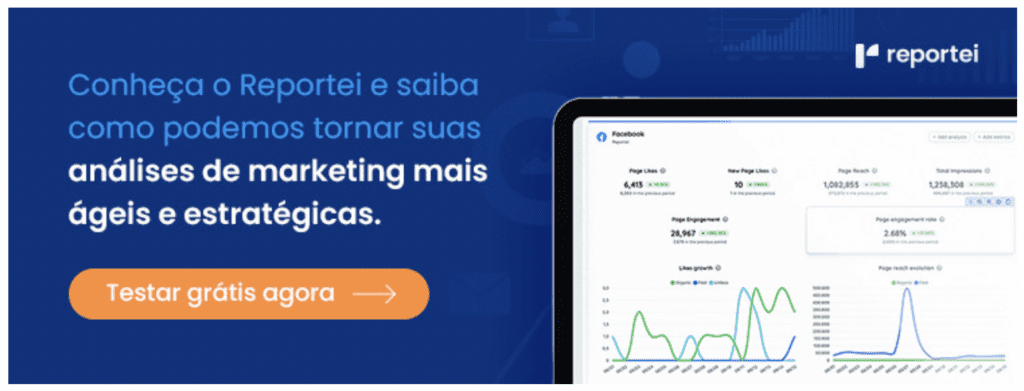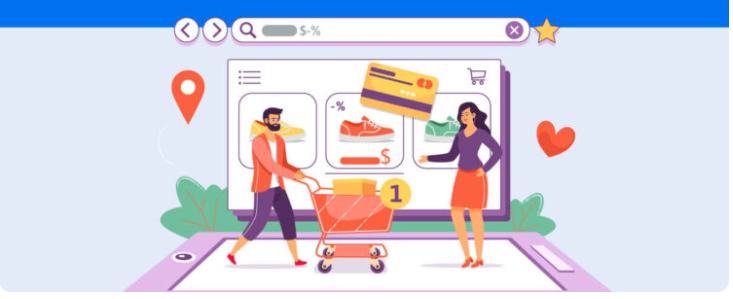Saiba o que é E-commerce Ads, conheça os principais canais para anunciar e veja dicas para obter sucesso com suas campanhas
Se o seu objetivo é acelerar as vendas da sua loja virtual, o E-commerce Ads é o atalho mais eficiente para atrair tráfego qualificado, testar ofertas com rapidez e escalar resultados com previsibilidade.
Na prática, trata-se de investir em mídia paga — seja no Google Ads, Meta Ads ou outros canais — para posicionar seus produtos diante das pessoas certas, no momento certo e com a mensagem mais persuasiva para cada etapa da jornada de compra.
A seguir, confira tudo sobre essa estratégia, seus benefícios e onde começar a anunciar!
O que é E-commerce Ads?
Como mencionamos acima, o E-commerce Ads é o conjunto de estratégias de mídia paga pensado para lojas virtuais.
Em outras palavras, trata-se de usar anúncios para conectar seu catálogo às pessoas certas — do primeiro contato à decisão — com mensagens ajustadas a cada momento do funil.
Ou seja, você investe para aparecer exatamente quando o cliente pesquisa, descobre ou compara produtos.
Isso pode acontecer nos buscadores (quando alguém digita “comprar tênis de corrida”), nas redes sociais (ao ser impactado por um review em vídeo) ou em outros pontos de contato digitais, como Pinterest e marketplaces.
Dessa forma, podemos ver que os benefícios aparecem em quatro frentes:
- Velocidade: ao ligar as campanhas, o tráfego chega no mesmo dia e as vendas podem acontecer sem depender apenas de SEO ou alcance orgânico;
- Intenção e alcance: ao estar presente onde as pessoas buscam e se inspiram, você conversa com públicos em diferentes estágios do funil — desde quem está começando a considerar uma solução até quem já está pronto para comprar;
- Mensuração e controle: com o rastreamento configurado, você acompanha métricas como CPA e ROAS, testa variações de criativos e lances, pausa o que não performa e direciona orçamento para o que dá resultado;
- Previsibilidade: por fim, conforme o histórico das campanhas cresce, fica mais fácil entender padrões, projetar metas e ajustar seus planos — seja para aproveitar uma sazonalidade, lançar uma nova coleção ou acelerar um produto campeão.
E-commerce Ads: onde anunciar?
Abaixo, selecionamos os principais canais que você pode utilizar para começar a fazer ads para e-commerce e obter os melhores resultados em todas as etapas do funil. Acompanhe!
1. Google Ads
Sem dúvidas o Google Ads é um dos canais mais relevantes para e-commerce, uma vez que capta intenção de compra de forma mais direta e entrega soluções de acordo com as necessidades do usuário.
Para isso, a plataforma oferece diferentes formatos de anúncios, sendo que os principais que você pode utilizar são:
- Rede de Pesquisa: exibe anúncios quando alguém procura termos como “comprar tênis esportivo”. Dessa forma, é indicado para quem já tem demanda e quer capturar usuários prontos para decidir;
- Rede de Display: são banners apresentados em sites e apps parceiros. Por isso, são ótimos para estratégias de remarketing (com público que visitou produtos ou abandonou carrinho), apresentar coleções e aquecer público;
- Shopping: são anúncios que mostram imagem, preço, nome da loja e avaliações direto nos resultados, como mostra o exemplo abaixo. Ou seja, são mais atrativos para quem sabe exatamente o que deseja comprar.
2. Facebook/Instagram Ads
Também chamados de Meta Ads, os anúncios para Instagram e Facebook funcionam muito bem para descoberta e prova social — especialmente se utilizarem criativos fortes e memoráveis.
Assim como no Google, você pode trabalhar com diferentes formatos para alcançar esses objetivos, como:
- Campanhas de Catálogo: com anúncios mostram produtos vistos/recomendados automaticamente. Com isso, são ideais para remarketing e upsell;
- Conversões/Advantage+ Shopping: usam automação e inteligência artificial para otimizar os anúncios e direcionar mais compradores para sua loja virtual;
- Reels/Stories/Feed: são formatos perfeitos para criativos rápidos, realizar demonstrações, compartilhar provas sociais e UGC (conteúdo gerado por usuários).
A partir de tudo isso, podemos ver que o Meta Ads é o canal ideal para quem busca ampliar alcance, testar ofertas, contar histórias de produtos ou nutrir públicos frios e mornos.
3. TikTok
Outro canal interessante para descoberta é o TikTok Ads. Afinal, sua linguagem dinâmica e baseada em tendências pode ser um diferencial para alcançar o público.
Seja para impulsionar conteúdos orgânicos ou veicular anúncios nativos com forte potencial viral, o importante é trabalhar com produtos com apelo visual, preço competitivo e narrativas autênticas – como reviews, unboxing ou tutoriais de “como usar”.
4. Pinterest
Enquanto isso, o Pinterest funciona como um motor de inspiração para os usuários. Sendo assim, é ótimo para categorias como decoração, moda, beleza e DIY.
Entre seus formatos, vale a pena destacar:
- Shopping Ads e catálogo: para veicular pins compráveis que encurtam a jornada;
- Consideração/tráfego: para gerar visitas qualificadas com alta intenção de compra.
Ou seja, é um excelente opção de canal para impulsionar coleções sazonais e produtos com forte apelo visual/estético.
5. Marketplaces
Por fim, plataformas como Amazon Ads, Mercado Livre Ads, Magalu Ads, Shopee Ads e similares operam dentro do ecossistema de busca do próprio marketplace.
Com isso, você ganha destaque nas páginas de resultado, o que aumenta as chances de vendas da sua loja com E-commerce Ads.
Desse modo, é ideal para quem deseja ganhar tração rápida, girar estoque e testar demanda.
Qual o melhor canal para anunciar?
A resposta para essa dúvida vai depender do objetivo, ticket médio, margem e estágio do seu negócio.
Mas, para ajudar na sua avaliação, preparamos o quadro comparativo a seguir:
| Canal | Objetivo principal | Quando usar | Forças | Custo relativo |
| Google Search | Capturar demanda | Produtos com buscas e intenção | Intenção alta, previsível | Médio a alto |
| Google Shopping/PMAX | Escalar catálogo | Lojas com feed otimizado | Visual, preço à vista | Médio |
| Display/Remarketing | Reaquecer e lembrar | Abandono de carrinho/visita | Alcance barato, frequência | Baixo a médio |
| Meta (FB/IG) | Descoberta e conversão | Criativos fortes, prova social | Segmentação ampla e catálogo | Baixo a médio |
| TikTok | Topo e meio do funil | Produto visual e jovem | Alcance e viralização | Baixo a médio |
| Inspiração e pesquisa | Moda, decoração e beleza | Intenção inspiracional | Baixo a médio | |
| Marketplaces | Venda imediata | Girar estoque | Confiança e volume | Variável |
Assim, é importante analisar que, enquanto o Google capta a intenção ativa de quem já sabe o que quer, Facebook, Instagram e TikTok ampliam o alcance e a consideração, despertando desejo e reforçando prova social.
Já os anúncios em marketplaces podem ser muito úteis para quem quer alavancar lojas nessas plataformas e vender de uma maneira mais direta.
Dicas para criar sua primeira campanha de E-commerce Ads
Agora que conhece os principais canais, confira um passo a passo para tirar sua primeira campanha do papel com segurança e foco em resultados, de forma a acelerar o aprendizado das plataformas:
1. Defina o destino e a métrica de sucesso
Antes de apertar “publicar”, escolha para onde mandar o usuário (página de produto, categoria ou coleção) e como vai medir o que é “bom”.
Isto é, traduza metas de negócio em KPIs para saber o que otimizar, quando pausar e onde ampliar o orçamento.
2. Comece de forma enxuta
Em vez de dezenas de variações, priorize uma estrutura simples para facilitar o diagnóstico.
Ou seja, use poucos grupos de anúncio, correspondências claras na rede de pesquisa e três a cinco criativos por conjunto em Meta/TikTok.
Com menos ruído, fica mais fácil identificar o que realmente move o ponteiro.
3. Alimente os algoritmos
Em seguida, garanta que você tenha sinais confiáveis de conversão. Para isso, instale pixel/SDK, configure eventos e importe conversões do GA4 quando fizer sentido.
Sem esse alicerce, as plataformas otimizam para cliques, não para vendas — o que costuma elevar o CPA e reduzir o ROAS.
4. Capriche no feed
Para Shopping/Performance Max, o feed é a sua prateleira. Sendo assim, invista em títulos com palavra-chave e marca, imagens de qualidade, preço competitivo e estoque atualizado.
Afinal, um feed bem cuidado melhora a aprovação na plataforma, aumenta o CTR e qualifica o tráfego que chega ao site.
5. Crie ofertas testáveis
Para acelerar o aprendizado e ajudar a aumentar conversões, trabalhe benefícios claros, como frete grátis, kits, desconto progressivo ou cross-sell.
Mas lembre-se de testar um incentivo por vez e observar o impacto em CTR, taxa de conversão e margem — assim você descobre o que sustenta um ROAS saudável.
6. Use remarketing inteligente
Para isso, estruture por profundidade e tempo de interação:
- 1 a 3 dias (quente): para abandono de carrinho/checkout;
- 7 a 14 dias (morno): para quem visitou produtos;
- mais de 30 dias (frio): gere incentivos mais “leves” para reativação.
Ajuste, ainda, a frequência para evitar saturação e exclua compradores recentes para não desperdiçar verba.
7. Estruture testes A/B
Com essa prática, você pode analisar o que funciona e o que precisa melhorar na sua estratégia de E-commerce Ads.
Porém, lembre-se de validar hipóteses mudando um elemento por vez (criativo, público, posicionamento ou lance), e defina um tempo mínimo de veiculação e um critério de vitória.
Dessa forma, você constrói aprendizado de maneira mais eficaz e toma decisões mais seguras.
8. Pense no pós-clique
Por mais que você tenha anúncios fortes, o direcionamento para uma página lenta ou pouco eficiente não ajuda a converter.
Sendo assim, sempre foque em velocidade, fotos nítidas, prova social (avaliações/selos), frete e prazo claros e checkout sem obstáculos.
Afinal, quanto mais simples for o processo para concluir a compra, menor tende a ser o CPA e maior o potencial de ROAS.
Analise os resultados de E-commerce Ads com o Reportei
Como destacamos bastante ao longo deste artigo, a análise de resultados é essencial para a otimização dos anúncios para e-commerce.
E para realizá-la de forma mais eficiente, você pode contar com o Reportei: uma solução completa que facilita a coleta, análise e interpretação dos dados de relatórios da sua loja virtual.
Inclusive, a partir da nossa ferramenta, você integra com as principais plataformas de e-commerce do mercado – como WooCommerce, Shopify e Nuvemshop – para consolidar métricas de vendas.
Ao mesmo tempo, conecta com Google Ads, Meta Ads, TikTok Ads, Pinterest Ads e outros canais para visualizar o desempenho de campanhas junto ao resultado real da loja — tudo em um só lugar.
Além disso, o Reportei oferece:
- Templates pré-configurados para e-commerce, com personalização total do layout;
- Reportei AI, com insights instantâneos por IA para destacar o que mais importa (picos, gargalos, oportunidades e anomalias);
- Dashboards em tempo real para acompanhar tráfego pago, SEO, redes sociais e canais de venda em um painel intuitivo;
- Monitoramento de indicadores e metas, ajudando você a medir avanço de CPA, ROAS, ticket médio e taxa de conversão.
Ou seja, ao centralizar e simplificar a análise, o Reportei libera seu tempo para o essencial: planejar campanhas melhores, corrigir rotas rapidamente e vender mais.
Experimente gratuitamente e veja como ele pode revolucionar a gestão e o crescimento do seu e-commerce!

FAQ: dúvidas frequentes sobre E-commerce Ads
A seguir, confira também um complemento com perguntas e respostas para tirar as dúvidas mais comuns:
O ideal é começar com um valor que gere dados (ex.: 20 a 50 conversões/mês por canal). A partir daí, você pode ajustar por CPA/ROAS e margem.
Enquanto Search captura a intenção existente, o Social cria demanda e trabalha a prova social. Dito isso, a combinação entre as duas estratégias costuma entregar o melhor ROI para as lojas virtuais.
Funciona melhor para lojas que possuem feed otimizado, preços competitivos e estoque estável. Sem isso, o algoritmo tem pouca tração para trabalhar e oferecer melhores resultados.
Antes de tudo, leve em conta a fase de aprendizado (de 7 a 14 dias, geralmente). Além disso, otimize após acumular conversões suficientes por conjunto.
Inspire-se, mas adapte seus criativos à sua proposta de valor. Em conjunto, lembre-se de que UGC, prova social e demonstrações reais costumam performar melhor.
Estruture campanhas por intenção, monitore sobreposição de públicos e centralize leitura de dados – por exemplo, você pode usar o Reportei para ter uma visão mais completa da estratégia e entender se um canal está prejudicando os resultados do outro.
Em geral, use para tração rápida, giro de estoque e teste de demanda. Em paralelo, construa sua marca em um site próprio, para não ficar refém de taxas.
Entre as principais estão: CPA (custo por aquisição), ROAS (retorno sobre o investimento em publicidade), taxa de conversão, CTR (taxa de cliques), CPC (custo por clique), ticket médio e LTV (lifetime value). Junto a isso, acompanhe também a aprovação do feed e a velocidade do site.



